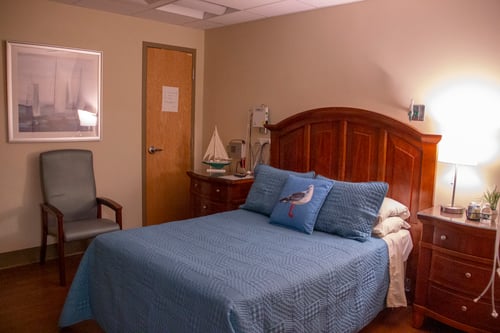- Before coming to the hospital
- Preparing For the sleep study
- Day of your sleep study
- During the Night
- After the Sleep Study
- Wash and dry hair
- Pack an overnight bag, like if staying at a hotel
- If oxygen is being used at home, please notify the center
- If a CPAP machine is used at home, please bring the mask and headgear – there's no need to bring your machine
- Do not use any hair spray, oils, or gels – hair should be clean and dry
- Continue taking regular prescriptions, but the Sleep Lab team needs to be made aware of what they are so that they can determine if a certain medicine is affecting sleep. Please bring these medications to the study
- Wear loose-fitting sleepwear
- Blankets and pillows or other comfort items are welcome
- Bring snacks since food will not be provided
- When arriving at the Sleep Lab, the technician will show patients to their rooms. As the technician gets the equipment ready, patients can change into any sleepwear and get ready for bed as they would at home. During this downtime, Wi-Fi can be used or the television. There may also be paperwork to be completed at this time
- Next, technicians will introduce patients to the equipment that will be used, the sleep study is explained in detail, and any questions may be answered
- The equipment includes:
- Approximately two dozen sensors that are applied to the skin using conductive paste and adhesive
- Elastic belts that are placed around the chest and abdomen
- A probe will also be placed on a finger
About the sensors
The sensors allow for the lab team to monitor the activities that are going on in the body during sleep, such as brain waves, muscle, and eye movements, snoring, etc. the elastic belts are used to measure the effort of breathing, and the finger probe monitors the level of oxygen in the blood and heart rate.
These devices are typically not a barrier to falling asleep and are designed to be as comfortable as possible. Sleep at the lab may not be exactly like sleep at home, but the process usually doesn’t interfere with obtaining the necessary information to make an accurate diagnosis or assessment.
Lights are turned off at 11 p.m. During the night, patients will be able to roll over and change positions. The technician, who is in a separate room, will be available if sensors should need re-adjusting or if a patient needs to use a restroom. Most patients have to get up at least once during the night. Patients are awakened by 6:30 a.m. and are offer a complimentary breakfast in the morning.
After the sleep study, a sleep technologist will process the data that was recorded and work with a physician who specializes in sleep medicine to interpret the data. Because the study provides extensive amounts of information, the technologist will review the study twice to ensure accuracy. The study provides over 1,000 pages of data so the interpretation process can take up to three weeks.
If a patient had a diagnostic sleep study, the physician will review the study and send the patient a basic letter of results, which will if someone tested “positive” or “negative” for sleep apnea. During the next appointment, this will be discussed further.
If a patient had a titration sleep study, the physician will review the study and a prescription for a PAP machine will be sent to Kent Home Medical Equipment, which will contact patients directly to coordinate the setup of the machine. The Center for Sleep Medicine will then be contacting patients to schedule a follow-up clinic appointment.

